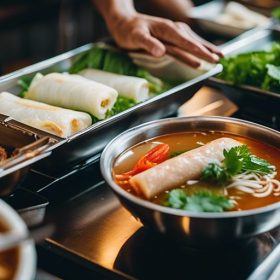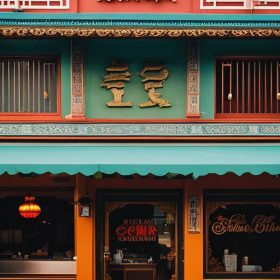Vietnamese cuisine is a rich and diverse culinary tradition that has been shaped by centuries of history and cultural influences. The cuisine of Vietnam is known for its vibrant flavors, fresh ingredients, and unique combinations of herbs and spices. Vietnamese food is a fusion of flavors from various regions, including China, Southeast Asia, and France.
The history of Vietnamese cuisine can be traced back to ancient times when the country was under Chinese rule. During this period, Chinese culinary techniques and ingredients were introduced to Vietnam, laying the foundation for what would become Vietnamese cuisine. Over the centuries, Vietnamese food evolved and incorporated influences from neighboring countries such as Cambodia and Laos.
Vietnamese cooking is characterized by its emphasis on fresh ingredients and the use of herbs and spices to enhance flavors. The cuisine is known for its balance of sweet, sour, salty, and spicy flavors. Some of the key ingredients used in Vietnamese cooking include fish sauce, soy sauce, lemongrass, chili peppers, and a variety of herbs such as mint, cilantro, and basil.
The Importance of Balance in Vietnamese Cooking
Balance is a fundamental concept in Vietnamese cuisine. The philosophy of yin and yang is applied to cooking to create harmonious dishes that are both flavorful and nutritious. Yin represents cooling and refreshing ingredients, while yang represents warming and energizing ingredients.
In Vietnamese cooking, balance is achieved by combining contrasting flavors and textures. For example, a dish may be made with both sweet and sour ingredients to create a harmonious blend of flavors. Similarly, a dish may be made with both crunchy and soft textures to provide a satisfying eating experience.
Balance is also achieved through the use of complementary ingredients. For example, a dish that is rich in flavor may be served with a side dish that is light and refreshing to balance out the meal. This balance of flavors and textures is what makes Vietnamese cuisine so unique and appealing.
The Role of Salty Flavors in Vietnamese Cuisine
Salty flavors play a crucial role in Vietnamese cuisine, adding depth and complexity to dishes. Two key ingredients that contribute to the saltiness of Vietnamese food are fish sauce and soy sauce.
Fish sauce, known as nuoc mam in Vietnamese, is a fermented condiment made from anchovies or other small fish. It is used as a seasoning in many Vietnamese dishes and adds a savory, umami flavor. Fish sauce is often used in marinades, dipping sauces, and soups to enhance the overall taste of the dish.
Soy sauce, known as tuong in Vietnamese, is another common ingredient in Vietnamese cooking. It is made from fermented soybeans and adds a salty and savory flavor to dishes. Soy sauce is used in stir-fries, marinades, and dipping sauces to add depth and richness to the flavors.
The use of fish sauce and soy sauce in Vietnamese cuisine is a testament to the country’s coastal location and its reliance on seafood as a source of protein. These ingredients not only add saltiness to dishes but also contribute to the overall umami flavor profile of Vietnamese food.
Exploring the Spicy Side of Vietnamese Food
Spiciness is another characteristic of Vietnamese cuisine that adds depth and complexity to dishes. Chili peppers are commonly used in Vietnamese cooking to add heat and flavor to various dishes.
Vietnamese cuisine uses a variety of chili peppers, ranging from mild to extremely spicy. The most commonly used chili pepper in Vietnam is the bird’s eye chili, which is small but packs a punch. Other varieties of chili peppers used include Thai chili peppers and serrano peppers.
Spices such as black pepper, ginger, and garlic are also used to add heat and flavor to Vietnamese dishes. These spices are often combined with chili peppers to create a complex and aromatic blend of flavors.
Spiciness is not only used to add heat to dishes but also to balance out other flavors. The heat from chili peppers can help cut through the richness of fatty meats or add a kick to a sweet and sour dish. Spiciness is an integral part of Vietnamese cuisine and adds a layer of excitement and depth to the flavors.
The Sweetness of Vietnamese Desserts and Snacks
While Vietnamese cuisine is known for its savory dishes, it also has a wide variety of sweet desserts and snacks. Vietnamese sweets are often made with ingredients such as coconut milk, rice flour, and tropical fruits.
One popular Vietnamese dessert is che, a sweet soup made with beans, fruits, and jelly. Che comes in many different flavors and variations, such as che ba mau (three-color dessert) and che dau xanh (mung bean dessert).
Another popular Vietnamese sweet is banh bao, a steamed bun filled with sweet fillings such as coconut, mung bean paste, or taro. Banh bao is often enjoyed as a snack or dessert.
Vietnamese cuisine also has a variety of sweet snacks, such as banh cam (deep-fried sesame balls filled with sweet mung bean paste) and banh chuoi (banana cake). These snacks are often enjoyed with a cup of Vietnamese coffee or tea.
The sweetness in Vietnamese desserts and snacks is balanced with other flavors such as saltiness or bitterness. This balance of flavors creates a harmonious taste that is both satisfying and refreshing.
The Versatility of Fish Sauce in Vietnamese Cuisine
Fish sauce is one of the most versatile ingredients in Vietnamese cuisine. It is used in a wide variety of dishes to add depth, umami, and complexity to the flavors.
Fish sauce is made by fermenting small fish or shrimp with salt. The resulting liquid is then strained and bottled. The fermentation process gives fish sauce its distinct flavor and aroma.
In Vietnamese cooking, fish sauce is used as a seasoning in marinades, dipping sauces, and soups. It is also used as a condiment to add flavor to dishes. Fish sauce can be used in both hot and cold dishes, and its flavor intensifies when cooked.
One of the most famous Vietnamese dishes that uses fish sauce is pho, a flavorful noodle soup. Fish sauce is added to the broth to enhance the overall taste of the dish. It adds a savory, umami flavor that complements the other ingredients in the soup.
Fish sauce is also used in stir-fries, salads, and grilled dishes to add depth and complexity to the flavors. It can be used as a marinade for meats or as a dipping sauce for spring rolls and other appetizers.
The versatility of fish sauce in Vietnamese cuisine is a testament to its importance as a flavor enhancer. It adds a unique umami taste that is characteristic of Vietnamese food.
The Unique Flavor of Lemongrass in Vietnamese Dishes
Lemongrass is a key ingredient in Vietnamese cuisine that adds a citrusy, herbaceous flavor to dishes. It is used in both savory and sweet dishes and is known for its refreshing and aromatic qualities.
Lemongrass has a strong lemony scent and flavor, but it is milder and sweeter than actual lemons. It is often used in marinades, soups, stir-fries, and curries to add a bright and zesty taste.
One popular Vietnamese dish that uses lemongrass is lemongrass chicken or beef. The meat is marinated with lemongrass, garlic, and other spices before being grilled or stir-fried. The lemongrass adds a unique flavor to the meat and helps tenderize it.
Lemongrass is also used in soups such as tom yum and pho to add a refreshing and aromatic element. It is often combined with other herbs and spices to create a complex and flavorful broth.
In Vietnamese desserts, lemongrass is used to add a subtle citrusy flavor. It is often combined with coconut milk and other sweet ingredients to create a refreshing and fragrant dessert.
The use of lemongrass in Vietnamese cuisine adds a unique and distinctive flavor that sets it apart from other cuisines. Its citrusy, herbaceous taste adds a refreshing element to dishes and enhances the overall flavor profile.
The Use of Herbs and Spices in Vietnamese Cooking
Herbs and spices are an integral part of Vietnamese cuisine and contribute to the unique flavors of the dishes. Vietnamese cooking uses a wide variety of herbs and spices, each adding its own distinct taste and aroma.
Some common herbs used in Vietnamese cooking include mint, cilantro, basil, and dill. These herbs are often used as garnishes or added to dishes at the end of cooking to add freshness and aroma.
Spices such as black pepper, ginger, garlic, and star anise are also commonly used in Vietnamese cuisine. These spices add depth and complexity to dishes and help balance out flavors.
One popular Vietnamese dish that showcases the use of herbs and spices is bun cha, a grilled pork noodle dish. The pork is marinated with garlic, ginger, and other spices before being grilled. The dish is then served with fresh herbs such as mint, cilantro, and lettuce.
Herbs and spices are also used in Vietnamese soups such as pho and bun bo hue to add flavor and aroma. They are often combined with other ingredients such as beef or chicken to create a rich and flavorful broth.
The use of herbs and spices in Vietnamese cooking adds layers of flavor to dishes and contributes to the overall complexity of the cuisine.
The Influence of French Cuisine on Vietnamese Food
The influence of French cuisine on Vietnamese food can be traced back to the period of French colonization in Vietnam, which lasted from the late 19th century to the mid-20th century. During this time, the French introduced their culinary techniques and ingredients to Vietnam, resulting in a fusion of French and Vietnamese flavors.
French cuisine had a significant impact on Vietnamese cooking, particularly in the areas of baking, pastries, and sauces. The French introduced bread, butter, and pastries to Vietnam, which are now staples in Vietnamese cuisine.
One of the most famous examples of the French influence on Vietnamese food is banh mi, a Vietnamese sandwich made with a baguette filled with various meats, vegetables, and sauces. The baguette is a direct result of French influence, while the fillings and flavors are distinctly Vietnamese.
French sauces such as mayonnaise and pate are also commonly used in Vietnamese cooking. These sauces add richness and flavor to dishes such as banh mi and banh cuon (steamed rice rolls).
The fusion of French and Vietnamese flavors has resulted in a unique culinary tradition that is both familiar and distinct. The French influence on Vietnamese cuisine is evident in the use of certain ingredients and techniques, but it has been adapted and transformed to suit the Vietnamese palate.
Regional Differences in Vietnamese Cuisine: From North to South
Vietnam is a geographically diverse country with distinct regional cuisines that vary from north to south. The regional differences in Vietnamese cuisine are influenced by factors such as geography, climate, and cultural traditions.
In northern Vietnam, the cuisine is characterized by its simplicity and use of freshwater ingredients. The region is known for dishes such as pho (noodle soup), bun cha (grilled pork noodle dish), and cha ca (grilled fish with turmeric and dill). Northern Vietnamese cuisine tends to be less spicy than other regions and relies heavily on herbs and vegetables for flavor.
Central Vietnamese cuisine is known for its bold and spicy flavors. The region is known for dishes such as bun bo hue (spicy beef noodle soup), mi quang (turmeric noodles with pork and shrimp), and banh xeo (crispy pancake filled with pork and shrimp). Central Vietnamese cuisine often incorporates a wide variety of herbs and spices to create complex and aromatic flavors.
Southern Vietnamese cuisine is influenced by the Mekong Delta region and has a strong emphasis on seafood and tropical fruits. The cuisine is known for dishes such as banh xeo (sizzling pancake), hu tieu (noodle soup), and goi cuon (fresh spring rolls). Southern Vietnamese cuisine tends to be sweeter and spicier than other regions, with a greater use of chili peppers and sugar.
The regional differences in Vietnamese cuisine reflect the diversity of the country’s landscape and cultural traditions. Each region has its own unique flavors and ingredients, making Vietnamese cuisine a rich and varied culinary tradition.
Popular Vietnamese Dishes You Must Try: Pho, Banh Mi, and More
Vietnamese cuisine offers a wide variety of delicious dishes that showcase the unique flavors and ingredients of the country. Here are some popular Vietnamese dishes that you must try:
1. Pho: Pho is a traditional Vietnamese noodle soup made with beef or chicken broth, rice noodles, and various toppings such as beef or chicken slices, bean sprouts, herbs, and lime. It is a staple dish in Vietnam and is known for its rich and aromatic flavors.
2. Banh Mi: Banh mi is a Vietnamese sandwich made with a baguette filled with various meats, vegetables, and sauces. It is a fusion of French and Vietnamese flavors and is known for its crispy bread and flavorful fillings.
3. Bun Cha: Bun cha is a grilled pork noodle dish that originated in Hanoi. It consists of grilled pork patties, vermicelli noodles, fresh herbs, and a dipping sauce. It is a popular street food in Vietnam and is loved for its smoky and savory flavors.
4. Goi Cuon: Goi cuon, also known as fresh spring rolls, are made with rice paper wrappers filled with shrimp, pork, herbs, and vegetables. They are often served with a peanut dipping sauce and are a refreshing and healthy snack or appetizer.
5. Com Tam: Com tam is a Vietnamese broken rice dish that is typically served with grilled pork chops, a fried egg, pickled vegetables, and fish sauce. It is a popular street food in Vietnam and is known for its combination of flavors and textures.
Conclusion:
Vietnamese cuisine is a fusion of flavors from various regions and cultures, resulting in a unique culinary tradition that is both vibrant and diverse. The cuisine is known for its balance of sweet, sour, salty, and spicy flavors, as well as its emphasis on fresh ingredients and the use of herbs and spices.
The use of fish sauce, lemongrass, and other ingredients adds depth and complexity to Vietnamese dishes. The influence of French cuisine can be seen in dishes such as banh mi and the use of sauces such as mayonnaise. Regional differences in Vietnamese cuisine reflect the diversity of the country’s landscape and cultural traditions.
Whether you’re a fan of savory dishes like pho and banh mi or have a sweet tooth for Vietnamese desserts like che and banh bao, Vietnamese cuisine offers something for everyone’s taste buds. With its rich and diverse flavors, Vietnamese cuisine is known for its balance of sweet, sour, salty, and spicy elements. From the fragrant herbs and spices used in dishes like lemongrass chicken and beef noodle soup to the fresh ingredients found in spring rolls and vermicelli bowls, every bite is a burst of deliciousness. And let’s not forget about the famous Vietnamese coffee, with its strong and bold flavor that pairs perfectly with a creamy condensed milk. Whether you’re exploring the street food stalls of Hanoi or dining at a high-end restaurant in Ho Chi Minh City, Vietnamese cuisine is sure to satisfy any food lover’s cravings.

Cuong Nguyen is a talented writer and experienced waitress at Vietnampalace.net, a renowned Vietnamese restaurant that offers an extensive menu of authentic Vietnamese cuisine. With a background in the competition of Vietnamese cuisine, Cuong brings a wealth of knowledge and expertise to the dining experience. From delicious pho dishes to fresh spring rolls, Cuong ensures that every meal is made with the freshest ingredients and authentic flavors.With exceptional service and a friendly atmosphere, Cuong takes pride in providing a memorable dining experience for every customer.
Whether you’re a vegetarian looking for options or a meat lover craving the flavors of traditional Vietnamese dishes, Cuong guarantees a delightful culinary adventure. So, visit Vietnampalace.net and let Cuong guide you through the tantalizing world of Vietnamese cuisine.



